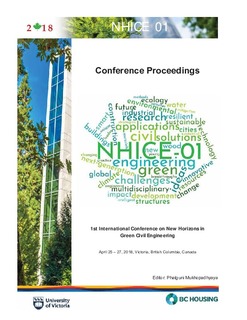| dc.contributor.author | Jelle, Bjørn Petter | |
| dc.contributor.author | Alex Mofid, Sohrab | |
| dc.contributor.author | Gao, Tao | |
| dc.date.accessioned | 2019-03-06T08:27:00Z | |
| dc.date.available | 2019-03-06T08:27:00Z | |
| dc.date.created | 2018-04-26T16:23:14Z | |
| dc.date.issued | 2018 | |
| dc.identifier.isbn | 978-1-55058-620-6 | |
| dc.identifier.uri | http://hdl.handle.net/11250/2588922 | |
| dc.description.abstract | Initiatives to incorporate energy efficiency measures and strategies in the building sector have gained attention for several decades, and with increased focus on zero energy and zero emission buildings, such initiatives will probably still continue to emerge for several more decades to come. Development of new high-performance thermal insulation materials and super insulation materials (SIM) for the advanced building envelopes of tomorrow may play an essential role in this regard. Very thick building envelopes are not desirable due to several reasons, e.g. considering space issues with respect to both economy, floor area, transport volumes, architectural restrictions and other limitations, material usage and existing building techniques. Hence, the stage is set for the development of new thermal insulation materials with a very low thermal conductivity, thus allowing the usage of relatively thin building envelopes with a very high thermal resistance and thereby substantially reduced heat loss. In porous materials, when the mean free path of the gas molecules becomes larger than the pore diameter, there will be a decrease in the gas thermal conductivity including the gas and pore wall interaction, which is referred to as the Knudsen effect. This study will present our on-going efforts utilizing the Knudsen effect attempting to make SIMs with a nanoporous air-filled structure at atmospheric pressure, i.e. nano insulation materials (NIM). Some possible pathways to NIMs and SIMs like e.g. the template foaming method and the internal gas release method are promising with respect to their high potential, however, so far large experimental challenges have made us abandon these methods for the moment. That is, currently we are pursuing to make NIMs by the sacrificial template method, more specifically by the synthesis of hollow silica nanospheres (HSNS), where both the inner sphere diameter and shell thickness may be tailor-made and thereby determining the thermal conductivity. | nb_NO |
| dc.language.iso | eng | nb_NO |
| dc.publisher | University of Victoria | nb_NO |
| dc.relation.ispartof | Proceedings of 1st International Conference on New Horizons in Green Civil Engineering (NHICE-01) | |
| dc.rights | CC BY NC SA | * |
| dc.rights.uri | http://creativecommons.org/licenses/by-nc-nd/4.0/deed.no | * |
| dc.subject | Knudsen effect | nb_NO |
| dc.subject | Super insulation material | nb_NO |
| dc.subject | Nano insulation material | nb_NO |
| dc.subject | Hollow silica nanosphere | nb_NO |
| dc.subject | Thermal conductivity | nb_NO |
| dc.title | Utilizing the Knudsen Effect in the Quest for Super Insulation Materials | nb_NO |
| dc.type | Chapter | nb_NO |
| dc.description.version | publishedVersion | nb_NO |
| dc.rights.holder | © 2018, Printed by the University of Victoria, British Columbia, Canada. This conference proceeding is released under a Creative Commons Attribution-Non-commercial- Share Alike 4.0 license (CC-BY-NC-SA). See creativecommons.org/ for more information. This proceeding, or parts of it, may be reproduced for non-commercial purposes, provided that proper attribution is given to the original author. The author grants the publisher a royalty-free worldwide non-exclusive license to publish, reproduce, display, distribute, archive and use the Article as part of the conference proceedings. | nb_NO |
| dc.subject.nsi | VDP::Teknologi: 500 | nb_NO |
| dc.source.pagenumber | 21-23 | nb_NO |
| dc.identifier.cristin | 1581956 | |
| dc.relation.project | Norges forskningsråd: 250159 | nb_NO |
| cristin.unitcode | 7401,30,40,0 | |
| cristin.unitname | Arkitektur, byggematerialer og konstruksjoner | |
| cristin.ispublished | true | |
| cristin.fulltext | original | |

